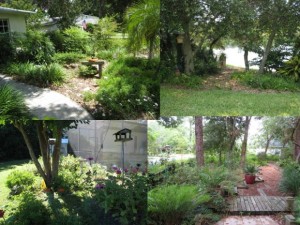 Public and private gardens, including the green places (Wildlife Corridors) in each individual’s yard, play a wide role in wildlife and bird conservation. They create an urban or suburban corridor to enhance migration. For instance, in Key West there is a corridor from the Botanical Gardens on Stock Island to the salt ponds beside the airport and on to 1800 Atlantic Condominium gardens, then to the Berg and Kitso Bird Preserves and across 1500 Atlantic Boulevard to McCoy Indigenous Park, ending at the Key West Garden Club. In that area are found such birds as ibis, herons, egrets, anhinga, mockingbirds, woodpeckers, pelicans, frigate birds, white-crowned pigeons and migrating turkey vultures, catbirds, grackles, ducks and warblers. Animals include opossums, snakes, frogs, geckos and box turtles. Bees, butterflies, wasps and insects of all kinds inhabit the corridor.
Public and private gardens, including the green places (Wildlife Corridors) in each individual’s yard, play a wide role in wildlife and bird conservation. They create an urban or suburban corridor to enhance migration. For instance, in Key West there is a corridor from the Botanical Gardens on Stock Island to the salt ponds beside the airport and on to 1800 Atlantic Condominium gardens, then to the Berg and Kitso Bird Preserves and across 1500 Atlantic Boulevard to McCoy Indigenous Park, ending at the Key West Garden Club. In that area are found such birds as ibis, herons, egrets, anhinga, mockingbirds, woodpeckers, pelicans, frigate birds, white-crowned pigeons and migrating turkey vultures, catbirds, grackles, ducks and warblers. Animals include opossums, snakes, frogs, geckos and box turtles. Bees, butterflies, wasps and insects of all kinds inhabit the corridor.
How easy is it to create such corridors? All it takes is removing some concrete, grass or pea rock and planting native trees and shrubs. Firebush will attract ruby-throated hummingbirds. No need to put out a hummingbird feeder, as their preferred food will be in your plants. And if you plant natives and don’t put out store-bought food to attract wildlife, you won’t attract rats either. This was the message that Kirsten Hines, author, photographer and nature guide, gave to the Key West Garden Club during a recent lecture. As if on cue, she pointed out the window and there was a hummingbird feeding on the orange tubular flowers of a firebush. “Wildlife chooses you, you do not choose them,” she said. “Whiteflies were chomping on my gumbo limbo leaves last year. I have never seen so many warblers in our yard devouring the whiteflies. If you have no yard, container gardening can create a miniature garden on a small scale. Birds don’t know the difference.“
Although non-native plants can be used as embellishments, the core of the garden should be native. Just like human babies, birds learn to eat what their mothers and fathers bring to the nest and avoid berries that are unfamiliar. Dead limbs and trees provide nesting cavities for a number of birds. Hines suggests that you diversity if you must have a grass lawn. Don’t make the lawn a desert monoculture of St. Augustine grass. “Set your mower higher and let the little weeds grow, and they will diversify on their own,” she said. “You’ll attract a flock of the ground feeders like ibis.” Store-bought mulch has insecticides in it and kills the insects that make the soil rich. Use natural leaves and twigs. Cut them into 6-inch pieces. Hines also objected to roaming cats. “Cats kill birds and they are so well-fed they don’t eat them. They bring them to lay in front of your door,” she said, citing statistics that show 1.4 to 3.7 billion birds a year are killed by cats. “Cat bites are also the largest source of rabies, so keep your cat inside.”
Key West Master Gardener Robin Robinson was a columnist for the Chicago Daily News and syndicated with Princeton Features. Her books are “Plants of Paradise” and “Roots, Rocks and Rain: Native Trees of the Florida Keys.”
